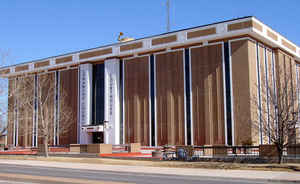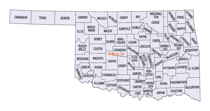Oklahoma Counties
There are seventy-seven counties in Oklahoma. Oklahoma originally had seven counties when it was first organized as the Oklahoma Territory. These counties were designated numerically, first through seventh. New counties added after this were designated by letters of the alphabet. The first seven counties were later renamed. The Oklahoma Constitutional Convention named all of the counties that were formed when Oklahoma entered statehood in 1907. Only two counties have been formed since thenComanche County, Oklahoma
Comanche County Education, Geography, and History

Comanche County is a county located in the state of Oklahoma. Based on the 2010 census, the population was 124,098, making it the
fourth-most populous county in Oklahoma. Its county seat is Lawton. The county was created in 1901 as part of Oklahoma Territory. It was named
for the Comanche tribe.
Comanche County is included in the Lawton, OK Metropolitan Statistical Area.
Etymology - Origin of Comanche County Name
Named for the Indian tribe, a corruption of the Spanish word "Camanche," possibly derived from Camino Ancho (i. e., broad road), referring to the great trail over which the Comanches raided from the Great Plains into the country south of the Rio Grande. In other words Comanche may have meant "the Indians of the Broad Road," thus the word Comanche being a contraction or combination of two words.
Demographics:
County QuickFacts: CensusBureau Quick Facts
Comanche County History
The land that is present day Oklahoma was first settled by prehistoric American Indians including the Clovis 11500
BCE, Folsom 10600 BCE and Plainview 10000 BCE cultures. Western explorers came to the region in the 16th century with Spanish explorer
Francisco Vaquez de Coronado visiting in 1541. Most of the region during this time was settled by the Wichita and Caddo people. Around the
1700s, two tribes from the North, the Comanches and Kiowas, migrated to the Oklahoma and Texas region.
For most of the 18th century, the Oklahoma region was under French control as Louisiana. In 1803, the Louisiana Purchase by Thomas Jefferson
brought the area under United States control. In 1830, Congress passed the Indian Removal Act, which removed American Indian tribes and
relocated them to Indian Territory. The southern part of the territory was originally assigned to the Choctaw and Chickasaw until 1867 when
the Medicine Lodge Treaty allotted the southwest portion of the Choctaw and Chickasaw's lands to the Comanche, Kiowa, and Apache tribes.
Fort Sill was established in 1869 by Major General Philip Sheridan who was leading a campaign in Indian Territory to stop raids into Texas by
American Indian tribes. In 1874, the Red River War broke out in the region when the Comanche, Kiowa and Southern Cheyenne left their Indian
Territory reservation. Attrition and skirmishes by the US Army finally forced the return of the tribes back to Indian Territory in June 1875.
In 1891, the United States Congress appointed a commission to meet with the tribal leaders and come to an agreement allowing white settlement
in the region. Years of controversy and legal maneuvering ensued before President William McKinley issued a proclamation on July 4, 1901, that
gave the federal government control over 2,000,000 acres (8,100 km2) of surplus Indian land.
Three 320-acre (1.3 km2) sites in Kiowa, Caddo and Comanche Counties were selected for county seats with Lawton designated as the Comanche
County seat. Non-Indian settlement was opened through an auction of lots beginning on August 6, 1901. In December 1906, the south regions of
the county reserved for grazing land reserved for American Indian livestock, Big Pasture, were open for settlement.
In 1910, the western portion of Comanche County and southern part of Kiowa County were used to create the short lived county of Swanson. After
a lawsuit brought by Comanche County, Swanson County was dissolved by the Supreme Court on June 27, 1911.In 1912, the southern portion of
Comanche County, which at the time extended to the Red River, were used to create the new county of Cotton County.
Oklahoma History Center
Named for the Comanche tribe, Comanche County lies within the Wichita Mountains region and the Red Bed Plains. The
county is drained by the West Cache, Cache, and Beaver creeks. Originally part of the Kiowa-Comanche-Apache Reservation,
the area was opened to non-Indian settlement by lottery on August 6, 1901. The county and the county seat of Lawton were
created on that day. In December 1906 the south-central part of Comanche County known as the Big Pasture was opened for
settlement by sealed bids. Located in southwestern Oklahoma, Comanche County is bordered on the north by Kiowa and Caddo
counties, on the east by Grady and Stephens counties, on the south by Cotton and Tillman counties, and on the west by
Tillman and Kiowa counties....COMANCHE
COUNTY
Geography: Land and Water
As reported by the Census Bureau, the county has a total area of 1,084 square miles (2,810 km2), of which 1,069 square miles
(2,770 km2) is land and 14 square miles (36 km2) (1.3%) is water.
Comanche County lies in an area that is typical of the Great Plains with prairie, few trees, and generally flat topography with gently rolling
hills. The north region of the county consists of the Wichita Mountains including Mount Scott and Mount Pinchot the area's highest peaks.
The area consists mostly of Permian Post Oak Conglomerate limestone on the northern sections of the county. In the south sections of the
county, Permian Garber Sandstone is commonly found with some Hennessey Group shale. Area creeks including East Cache Creek and West Cache
Creek contain deposits of Quaternary alluvium. To the northwest, the Wichita Mountains consist primarily of Wichita Granite Group from the
Cambrian era.
There are three cities in Comanche County. The largest, Lawton is located in the center of the county and is the county seat.According to the
US census, the population of Lawton was 96,867 in 2010, which is 78 percent of the county's population. Cache is located to the west of Lawton
on US Highway 62 and has a population of 2,796. In the northeast, Elgin is located along Interstate 44 and has a population of 2,156. Several
towns dot the county including: Fletcher, Sterling in the northeast, Medicine Park in the north central region, Indiahoma in the west,
Geronimo in the southeast, and Chattanooga and Faxon in the southern regions of the county. Also located in Comanche County is Fort Sill. The
90,000 acre instillation is home to the US Army Field Artillery Training Center and the Air Defense Artillery.
Protected areas in Comanche County include the 59,020 acre Wichita Mountains Wildlife Refuge. Established in 1901 the refuge is one of the 546
wildlife refuges throughout the United States to provide a natural habitat for native grazing animals like the Bison, Elk, and Texas longhorn
cattle.
Neighboring Counties
Bordering counties are as follows:
- Kiowa County (northwest)
- Tillman County (southwest)
- Cotton County (south)
- Stephens County (southeast)
- Grady County (northeast)
- Caddo County (north)
Education
The county has ten independent school districts. The largest is Lawton Public Schools which had 16,398 in 2009. The district operates two
pre-kindergarten centers, twenty-six elementary schools, four middle schools, and three high schools - Eisenhower, Lawton, and MacArthur.
Other major school districts in the area include Cache Public Schools and Elgin Public Schools. Cache Public Schools had an enrollment of
1,648 and consists of five schools. Elgin Public Schools had an enrollment of 16,98 and three schools. Other public school districts in the
region include, Bishop Chattanooga, Fletcher, Flower Mound, Geronimo, Indiahoma, and Sterling.
Comanche County includes several private schools. The largest is Lawton Christan School with an enrollment of 426 students in 2009. Lawton
Academy of Arts & Science offers classes from PK-12 and had an enrollment of 115.[54] St. Mary's Catholic School offers classes for elementary
and middle school. Trinity Christian Academy offers classes from K-3 through the 8th grade.
There is one university in Comanche County, Cameron University. Cameron is the largest four year, state-funded university, in southwest
Oklahoma, offering more than 50 degree programs in areas of Business, Education, Liberal Arts and Science and Technology. Founded in 1909,
Cameron has an average fall enrollment of 6,000 students with 70 endowed faculty positions.
Comanche County is also served by the Great Plains Technology Center, which is part of the Oklahoma Department of Career and Technology
Education System. Great Plains provides occupational education, training, and development opportunities to area residents.







